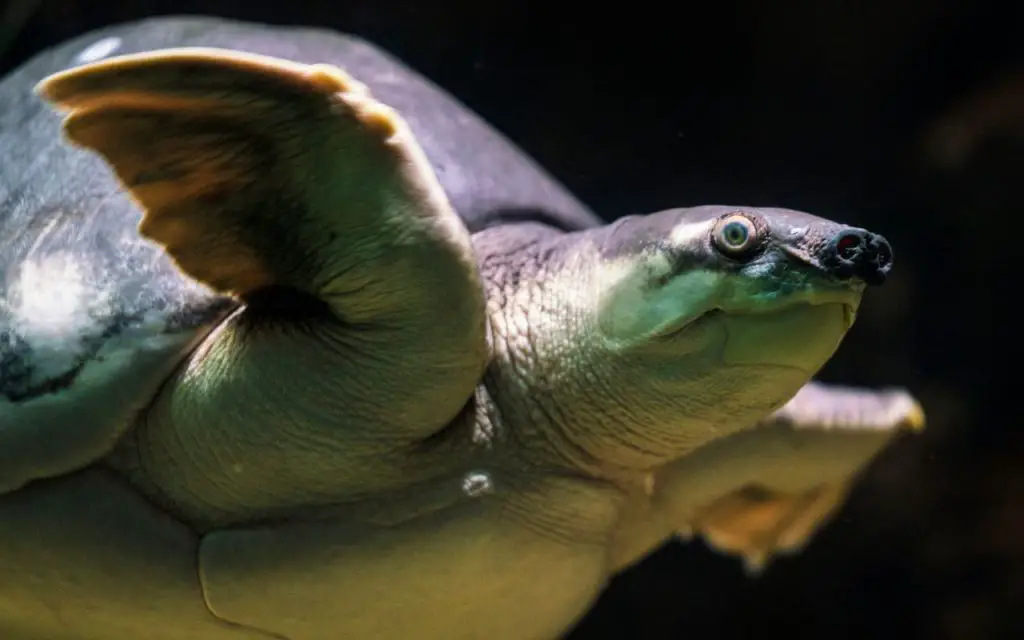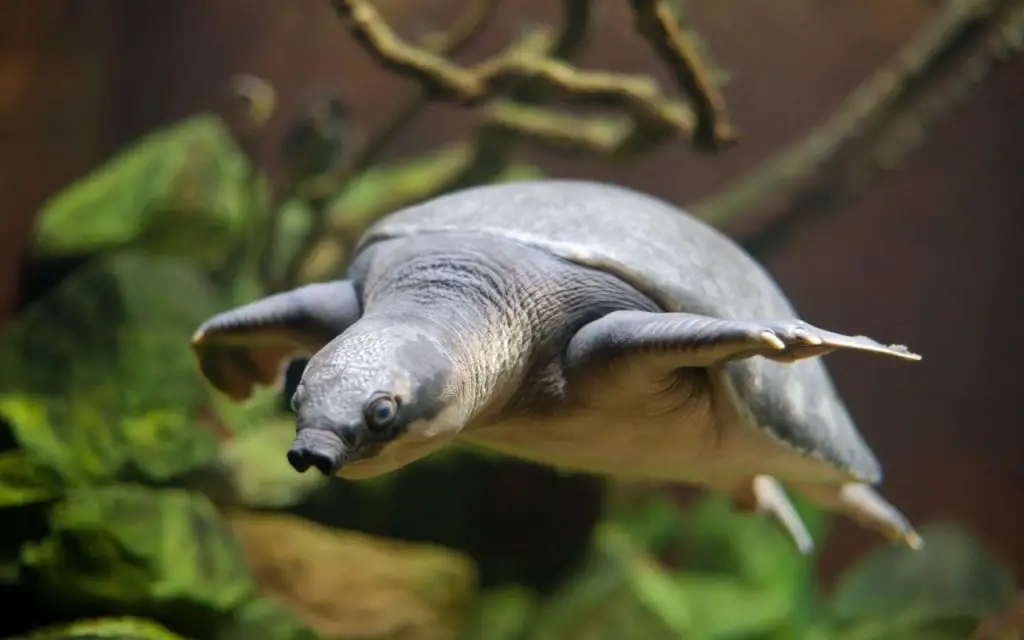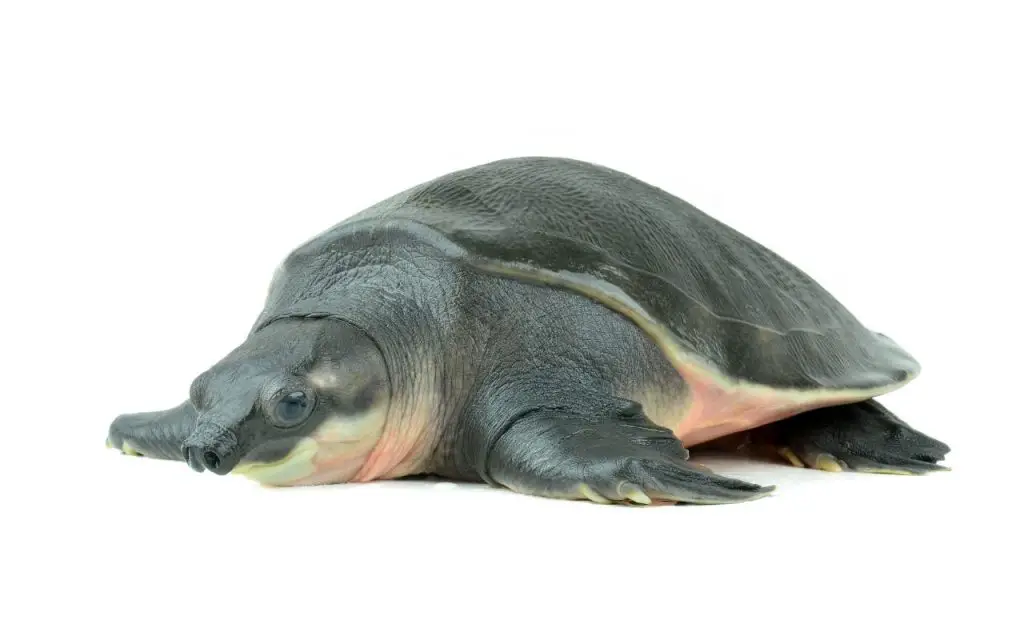The Fly River Turtle, also known as the Pig-nosed Turtle, is possibly the weirdest fresh-water turtle on the planet. Keep reading to learn more…
Last updated on December 12th, 2022 at 06:35 pm
If you want to know more about the Fly River Turtle, read this article. Here you will learn about its diet, lifespan and habitat. In addition to that, you will learn how to identify it by looking at the video below. You can also learn about its endangered status by reading the following paragraphs.
Habitat
The Fly River turtle spends the majority of its life in the water and is only prone to leaving its aquatic habitat to lay its eggs. This means that it avoids low-elevation forests and areas at risk of flooding or drought.
Females travel to nesting sites together, and use their hind limbs to dig a nest. The eggs incubate for 64 to 107 days.
The temperature of the water and the nesting area determines the sex of the hatchlings, with higher temperatures producing more females than lower ones.
In addition, young Fly River turtles delay hatching for up to 50 days, and the first rains flood their nests, triggering the hatching of eggs.
The natural history of the Fly River turtle reveals that its omnivorous diet is an adaptation to drastic changes in its habitat. These turtles tend to congregate under overhanging branches, where they can easily detect food sources and avoid predators.
They can also tolerate salty water, allowing them to live in coastal areas. In addition, they use thermal springs on the bed of rivers to warm themselves, which is essential for gravid females.
Fly River Turtle Size

The Fly River Turtle is a large aquatic turtle that can grow up to 70 centimeters (27.5 inches) in length and 30 kilograms (66 pounds).
These creatures are typically larger than other species, with males having larger carapaces and leaner tails than females.
This turtle is named after the Fly River, a tropical river in Papua New Guinea. Its habitat is tropical rivers with a slow current and soft bottoms. It can live up to seven meters deep.
The Fly River Turtle is a large aquatic freshwater turtle. Its appearance is similar to softshell turtles found in North America, but it has a thicker snout, streamlined shell, and prominently divided nostrils.
It is the only member of its order, Cryptodira, and is not related to other softshell turtles. However, it is a great addition to the aquarium community due to its striking size.
Is the Fly River Turtle endangered?
The range of the Fly River Turtle is in the Northern Territory of Australia, as well as in Papua New Guinea. It lives in large waterholes, lagoons, and other freshwater habitats. Their lifespan is about 35 to 40 years.
However, like the Eastern Box Turtle we discussed in a previous article, this species has been declining in number in recent years. It is now listed as a vulnerable species.
This is largely due to human consumption and the international pet trade. Agricultural use and mining have also negatively affected the turtle’s habitat.
The Fly River turtle is known for its large, fleshy snout, which allows it to breathe while submerged. This feature allows the turtle to sniff out prey and detect scents.
Their webbed flippers are reminiscent of sea turtles, and they use them for steering and paddling. The turtle has strong jaws and a claw on its forelimbs to grasp objects and avoid predators.
The Fly River turtle is also known as the pig-nosed turtle or pitted-shelled turtle. It is found in southern New Guinea, northern Australia, and Papua New Guinea.
It is the only species in the Carettochelyidae family to survive, but there are several other extinct species around the world. The Fly River turtle is now the only one of its kind left.
Diet

The diet of a Fly River Turtle consists of a variety of foods. While these creatures typically prefer a vegetarian diet, they do appreciate fresh fruit, leafy greens, and fish pieces.
You can also offer them a cuttlebone, which improves their calcium metabolism. The diet of a Fly River Turtle should be balanced so that it remains healthy and active. Its digestive system is best suited to vegetarian foods.
Pig-nosed Turtles spend their lives in fresh water, but will occasionally venture into brackish water. Coastal waters also contain these creatures. Most of their diet is made up of aquatic plants, but they also supplement their diet with a variety of small prey.
Their new hatchlings survive on egg yolk and hunt insects and snails. Their natural diets are very diverse, so the diet of a Fly River Turtle should be balanced and varied.
The Fly River Turtle diet includes:
- water snails
- shrimp
- aquatic plants (such as water hyacinth)
- insects
- fallen fruit
- earthworms
- fish
Fly River Turtle Lifespan
The life span of a Fly River turtle varies wildly from one individual to the next, but generally falls somewhere between seventeen and forty years.
They spend most of their lives in the water, but may leave the water for nesting sites, where they must stay out of the reach of predators such as saltwater crocodiles and monitor lizards. Female Fly River turtles lay two clutches of eggs a year, and mate only every two years.
This species is named for a river that flows through Papua New Guinea, but it can also be found in southern Indonesia and northern Australia.
Their populations have been destroyed by human consumption and international pet trade.
The Fly River turtle can grow up to 50 pounds and is 22 inches long with a thick tail. It can live in water up to seven meters deep.
Captive bred Fly River Turtle

A Captive bred Fly River Turtle is a wonderful pet to own, especially for those who love sea turtles (which are strictly illegal to own).
They have a gray body with white undersides, leathery skin, and streamlined shells. Their snouts are filled with papillae and absorb oxygen in water.
In addition, their snouts serve as sensory organs and aid them in searching for food, which is fascinating to watch. In addition, they have strong jaws and claws on their forelimbs.
While the name ‘Fly River Turtle’ might seem like an oxymoron, this large, aquatic freshwater turtle is actually a rare species.
Besides being found only in southern New Guinea and northern Australia, the Fly River Turtle also goes by the common names pig-nosed turtle and fly river turtle.
These creatures have prominently divided nostrils and a thick fleshy snout, which are distinctive traits of this species. They also resemble soft-shelled turtles, but are not closely related to them.
The Captive bred Fly River Turtle is an expensive animal, that requires a lot of room. They can reach a maximum length of 22 inches (56 cm) and weigh nearly 40 pounds (20 kg).
If you’re limited for space, or budget, a smaller species would be a better choice.
Things to consider before buying:
- they get big
- are exclusively aquatic
- need a lot of room
- they’re worth it – if you can afford to house them!
Baby Fly River Turtle for sale
If you are looking for a pet turtle, you might be interested in a Baby Fly River Turtle for sale.
This species is beautiful, but requires a lot more room than more common pet turtles – even more than Alligator Snapping Turtles, for example.
These critters are endangered in the wild, so captive breeding is needed to save them from extinction. Hopefully, hobbyist keepers will play a role in this.
Because of their active lifestyle, this species is best kept in a private pond or very large aquarium with nesting beaches.
Baby Fly River Turtles aren’t widely available, and should be bought if they are guaranteed captive-bred.

Fly River Turtle Tank size
The Fly River Turtle is a rare type of turtle that can be housed in a wide range of tanks. However, the tank size that’s right for a particular turtle depends on several factors.
In general, adult Fly River Turtles will need at least a 200 gallon tank and excellent water quality. To find out more about this, I recommend heading over to Austin’s Turtle Page to see his care sheet.
The turtle needs ample lateral swimming space, a sand substrate, and hiding places. The water in the tank should be well filtered and the enclosure should have reinforced casing.
You can also consider installing a UV-Sterilizer and additional aquatic plants to aid in the water quality. If you’re unsure about the size of your tank, consider purchasing a custom made aquarium.
Hence, choosing a suitable aquarium for your turtle is very important. To make sure that your turtle will be happy and healthy, select a tank that’s large enough for both the turtle and the fish.
